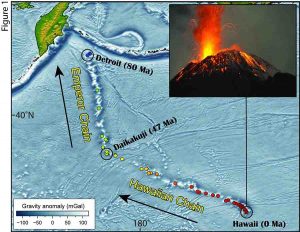
The volcanic islands of Hawaii represent the youngest end of a 80 million years old and roughly 6,000 kilometres long mountain chain on the ground of the Pacific Ocean. The so-called Hawaiian-Emperor chain consisting of dozens of volcanoes is well known for its peculiar 60 degrees bend. The cause for this bend has been heavily debated for decades. One explanation is an abrupt change in the motion of the Pacific tectonic plate, the opposite model states southward drift of the mantle plume that has sourced the chain since its beginning 80 million years ago. Apparently both processes play an important role, shows a new study in Nature Communications, published by a group of scientists from the University of Oslo, German Research Centre for Geosciences GFZ Potsdam, and Utrecht University.
Many volcanic ocean islands are created by columnar shaped hot upwellings called mantle plumes that originate near the ~3000 km deep base of Earth’s mantle. Mantle plumes are not much influenced by surface motions of the tectonic plates that slowly move over them. Hence, long linear chains of plume-sourced volcanoes that get older and older with increasing distance from active hotspots can be tracked for hundreds to thousands of kilometres. In the Hawaiian hotspot trail, the Hawaii islands are the youngest in the chain that stretches nearly 6,000 km to Detroit seamount in the northwest Pacific, where volcanism occurred about 80 million years ago. An unprecedented 60 degrees bend characterizes the Hawaiian-Emperor Chain, dividing it into the older Emperor Chain and the younger Hawaiian Chain. The bend has been dated to 47 Ma (Fig. 1).
“The ultimate cause for the formation of the Hawaiian-Emperor Bend (HEB) was a prominent change in the Pacific plate motion at 47 Ma”, says the lead author of the new study, Trond Torsvik from the University of Oslo and visiting researcher at GFZ at the moment. The team affirms a hypothesis by the US-geophysicist Jason Morgan who proposed that already in the early 1970s. “But it is not that simple as it was suggested forty years ago”, says Torsvik.
Jason Morgan was the first to use hotspots as a reference frame for global plate motions. In his model mantle plumes—which are manifested by hotspots at the surface—were considered fixed in the mantle, and the Hawaiian-Emperor Bend was attributed to a simple directional change of the Pacific plate motion. But his plate model with fixed hotspots became challenged from the 1980s.
“Since the late 1990s it has become clear that hotspots are not totally fixed”, says GFZ´s Bernhard Steinberger, one of the co-authors of the paper. That is now generally accepted, he adds, and mantle flow models predict that the Hawaiian hotspot has drifted slowly to the south. “But some recent studies have argued that rapid southward motion of the hotspot before 47 Ma can explain the formation of the bend without requiring Pacific plate motion change”, he says. “Such a scenario has become attractive because the geology of the plates surrounding the Pacific shows no clear evidence for a Pacific plate motion change.”
The new study shows clearly why this simply does not work. It would require an unrealistically high rate of hotspot motion of about 42 cm/year which would be much faster than the average speed of tectonic plates. Moreover, this would imply that the Emperor Chain was created in just five million years and Detroit Seamount should only be 52 million years old (Fig. 2a). This prediction is obviously falsified by the recorded Detroit Seamount island ages of about 80 Ma (Fig. 1).
“Alternatively, a slower hotspot motion towards the WSW could explain both geometry and ages of the Emperor chain”, says Steinberger. However, such a direction of motion is inconsistent with mantle convection models.
“Our paper is a good example of how very simple simulations of plate and hotspot kinematics can be used to explore which geodynamic scenarios for the formation of the Hawaiian-Emperor Bend are possible, and which ones are not”, says Pavel Doubrovine from the University of Oslo, another co-author on the paper. “We cannot avoid the conclusion that the 60 degrees bend is predominantly caused by a directional change in the Pacific plate motion.” Yet, some southward plume motion is required (blue line in Fig. 2b), otherwise the Hawaiian-Emperor Chain would be around 800 kilometres shorter.
“Explaining the geometry, length and age progression of the Hawaiian-Emperor Chain, requires both: the change in the direction of plate motion and the movement of the hotspot”, states Torsvik. “If, after more than two decades of debating the end-member scenarios of plate motion change versus hotspot drift, geophysicists will be able to agree that neither of the two is satisfactory – then we can move forward and address a more interesting question: what actually drove the Pacific plate motion to change at about 47 million years ago?” Hopefully, it will not take further 40 years to get an answer to this, he adds.
Reference:
Trond H. Torsvik et al, Pacific plate motion change caused the Hawaiian-Emperor Bend, Nature Communications (2017). DOI: 10.1038/ncomms15660
Note: The above post is reprinted from materials provided by Helmholtz Association of German Research Centres.









